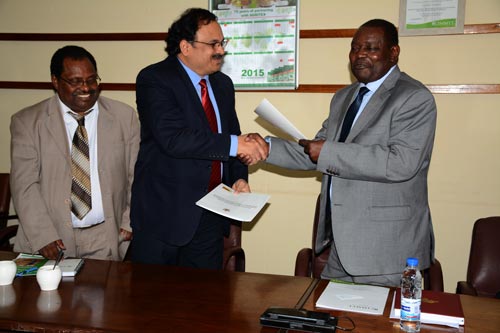A modern quarantine facility to safely import maize breeding materials to southern Africa, and to enable local institutions to proactively breed for resistance against Maize Lethal Necrosis (MLN) disease, will be established this year at Mazowe, just outside Harare in Zimbabwe.

After the signing ceremony, BM Prasanna, MAIZE CRP Director, shakes hands with Ringson Chitsiko, the Permanent Secretary of Zimbabwe’s Ministry of Agriculture. Looking on, is Mulugetta Mekuria, CIMMYT-SARO Regional Representative. Photo: Johnson Siamachira
The announcement was made on 3 August 2015 at the signing ceremony of a Memorandum of Agreement (MoA) between CIMMYT and the Government of Zimbabwe. Ringson Chitsiko, the Permanent Secretary of Agriculture, Mechanization and Irrigation Development, signed on behalf of the Government of Zimbabwe while BM Prasanna, Director of MAIZE CRP and CIMMYT’s Global Maize Program, represented CIMMYT.
“MLN is a reality that cannot be ignored. We have to work together to control its spread. We need to focus on finding practical solutions to tackle this complex challenge, including strengthening MLN disease diagnostic and surveillance capacity, while we continue with intensive inter-institutional efforts to develop and deploy improved maize varieties that incorporate MLN resistance. The commercial seed sector must also play a key role by producing and delivering MLN-free healthy seed to farmers,” said Prasanna during the MoA signing ceremony.
The MLN Quarantine Facility, the first of its kind in southern Africa, will be set up by CIMMYT before the end of this year at the Plant Quarantine Institute in Mazowe, Mashonaland Central Province, one of Zimbabwe’s important research facilities run by the Department of Research and Specialist Services (DR&SS).
MLN was first detected in Kenya’s Rift Valley region in September 2011, and has since been reported in Tanzania, Uganda, Democratic Republic of Congo, Rwanda and Ethiopia. It is caused by a double infection of maize plants by two viruses: maize chlorotic mottle virus and sugarcane mosaic virus. There is an urgent need to prevent the deadly disease from moving further south.
Prior to signing of the MoA, Joseph Made, Zimbabwe’s Minister of Agriculture, discussed with Prasanna and CIMMYT-Southern Africa Regional Office (CIMMYT-SARO) senior staff how to strengthen maize research and development in Zimbabwe. “The Government of Zimbabwe is honored to be selected to host the new facility, which is important for stopping the spread and impact of MLN,” said Made.
To strengthen the phytosanitary work at the MLN Quarantine Facility, CIMMYT will also offer capacity building to DR&SS researchers through trainings, technical assistance, and advisory services, according to Prasanna. “This MLN Quarantine Facility, and the collaborative efforts between institutions of the Government of Zimbabwe, especially DR&SS and CIMMYT-SARO, are key in our efforts to prevent the possible spread of MLN in Africa,” said Prasanna.
Mulugetta Mekuria, CIMMYT-SARO Regional Representative said that the new collaboration to set up the MLN Quarantine facility in Zimbabwe would further enrich the long-standing and successful partnership between CIMMYT-SARO and DR&SS.
After the signing ceremony, officials from CIMMYT and DR&SS visited the site at the Plant Quarantine Institute at Mazowe where the MLN Quarantine Facility will be established, and discussed implementation arrangements, including steps for strengthening the national phytosanitary capacity.
 Nutrition, health and food security
Nutrition, health and food security 
